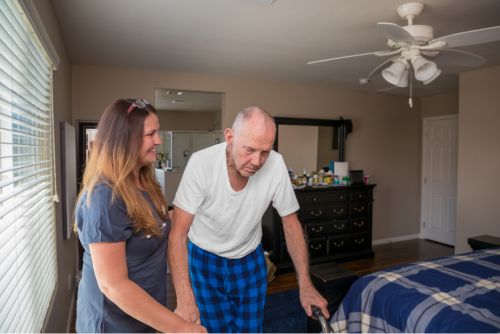As we age, our needs and abilities change, prompting many individuals to consider assisted living as a viable option for their later years. Assisted living facilities provide a blend of independence with some help in daily activities and medical care, offering a safe and comfortable environment for seniors. One of the essential questions surrounding assisted living is: how long do most people live in assisted living facilities?
Determining the duration of stay in assisted living depends on numerous factors, including residents’ health conditions, the level of care they require, and their financial situation. Understanding the average stay in assisted living can help individuals and families make informed decisions about their long-term care planning and evaluate which housing options best suit their needs and preferences.
Key Takeaways
- Assisted living facilities offer residents independence combined with necessary support.
- The duration of stay in assisted living depends on health, care needs, and financial factors.
- Knowing the average stay can aid in long-term care planning and housing decisions.
What Is Assisted Living
Assisted living is a type of housing option that is specifically designed for seniors, particularly those who require some assistance with daily tasks but do not need the extensive medical care provided in a nursing home. I think that assisted living facilities combine elements of independence and assistance, with residents living in apartment-style units, while receiving personalized, supportive services.
In assisted living communities, I find that residents often receive help with activities of daily living (ADLs) such as bathing, dressing, and medication management. In addition, these communities typically provide a range of services and amenities, including meals, housekeeping, laundry, and social activities for the residents. This allows seniors to maintain their independence while receiving the assistance they need in a safe and supportive environment.
There are various types of assisted living facilities available, catering to a wide range of needs and preferences. Some communities may be smaller and more homelike, while others could be larger with resort-like amenities. The level of care provided can also vary between facilities, as some may focus on residents with specific needs, such as memory care or diabetes management.
Assisted living care is typically personalized and flexible, with staff members working closely with residents and their families to develop care plans tailored to individual needs. This ensures that seniors receive the right level of care and support while maintaining their dignity and quality of life.
Average Age in Assisted Living

I have found that the average age of residents in assisted living facilities is typically around 85 years old. In the United States, more and more seniors are moving into assisted living communities as they age, with many of them entering these facilities around the age of 65.
- Age 65: This age has become a significant milestone for many Americans, as it is commonly associated with retirement and the start of one’s golden years. With the aging population of baby boomers, the number of seniors requiring assistance with daily activities is on the rise.
- Seniors: The assisted living industry primarily serves seniors who need help with activities of daily living but do not require the level of care provided in nursing homes. These individuals commonly have chronic health conditions or require help with medication management, mobility, or personal care.
- Americans: According to the U.S. Census Bureau, there were over 54 million Americans aged 65 and older in 2019, comprising approximately 16% of the total population. As the number of seniors increases, the demand for assisted living housing options is continuing to grow.
- Baby Boomers: Born between 1946 and 1964, the baby boomer generation is currently entering their retirement years, further driving the need for assisted living facilities. It is estimated that by 2030, there could be more than 74 million Americans over the age of 65, making quality assisted living communities an essential aspect of long-term care.
Longevity in Assisted Living

I have observed that the duration of stay in assisted living varies depending on individual needs and circumstances. Assisted living is a type of long-term care that provides assistance with daily living activities, such as bathing, dressing, and medication management. The national average length of stay in assisted living is around 22 months. However, it’s important to note that this number can differ significantly for each person.
In my research, I found that the rates of assisted living are influenced by various factors, including health status, level of care required, and availability of family support. Some people may only need assisted living for a short period, while others might require long-term care. The statistics show that the majority of residents tend to stay in assisted living for one to three years.
It is essential to consider that assisted living communities are designed to offer different levels of care to accommodate diverse needs. For many individuals, assisted living can be a stepping stone to more specialized care, such as memory care or skilled nursing facilities. Others may find that they can maintain their independence and quality of life with minimal assistance.
In conclusion, longevity in assisted living depends on various factors and personal circumstances. While the national average length of stay is around 22 months, individual experiences can differ greatly. By understanding these factors and each person’s unique situation, a more accurate prediction can be made for how long someone might stay in an assisted living community.
Gender Considerations in Assisted Living

I have noticed that men and women have different experiences when it comes to assisted living. Both genders may face unique challenges and expectations, but it is essential to understand and address these differences to enhance the quality of life for all residents. These factors also affect how long do most people live in assisted living facilities.
In some cases, I have seen that women tend to outlive men, leading to a higher percentage of women in assisted living communities. This gender imbalance can impact the social dynamics and availability of suitable companions or friends for male residents.
When it comes to the care provided in assisted living, I believe that it is vital to consider each person’s specific needs, regardless of gender. Tailoring care plans to address the unique health concerns faced by men and women can greatly improve their overall well-being. For instance, women in assisted living may require more attention to issues such as osteoporosis and urinary incontinence, whereas men might need assistance with prostate health or mobility.
Another important aspect is understanding the differences in social needs and preferences between men and women. Providing engaging activities catering to diverse interests, such as sports for men and crafts for women, can encourage social interactions and improve overall satisfaction with the assisted living experience.
Finally, I have observed that respecting each resident’s personal preferences, regardless of gender, is crucial. It is essential to provide a safe and welcoming environment that acknowledges and supports the identity and background of all individuals living in assisted living communities.
By being mindful of these differences and working to address the unique needs of men and women in assisted living, I am confident that the overall quality of life for all residents can be significantly enhanced, allowing them to enjoy their remaining years in a supportive and nurturing environment.
Factors Affecting Duration of Stay

When I consider the factors that affect the duration of an individual’s stay in assisted living, I must think about various aspects, including daily life activities, chronic conditions, and geographical locations. These factors can play a significant role in the longevity of a person’s stay in such a facility.
The ability to perform activities of daily living (ADLs) is a key factor contributing to the length of time spent in assisted living. As individuals age, they may require more assistance from caregivers for tasks such as bathing, dressing, and eating. Those who struggle with a higher number of ADLs may need additional support, leading to a longer duration in assisted living.
Chronic conditions also have a substantial impact on the duration of a person’s stay in assisted living. For instance, the presence of diabetes, arthritis, or high blood pressure may necessitate ongoing care and specialized support. Maintaining these conditions and managing their symptoms can influence the extent of assistance required, which in turn affects the length of stay in these facilities.
Geographical location plays a role as well. In areas with large elderly populations, such as Florida and South Florida, there may be more availability and accessibility to assisted living facilities, potentially leading to longer stays for residents. Additionally, seniors who relocate to these regions may have a better understanding of their care needs and seek out assisted living sooner, resulting in a longer duration of residence.
In conclusion, various factors influence the duration of a person’s stay in assisted living. The ability to perform daily activities, the presence of chronic conditions, and geographical location all contribute to the length of time an individual may reside in such a facility. Providing the appropriate level of support and care for these needs is crucial for ensuring a comfortable and safe environment for seniors in assisted living.
Healthcare Services Within Assisted Living Facilities

As a person with knowledge in assisted living, I can confidently say that healthcare services within assisted living facilities vary to cater to the specific needs of each resident. Assisted living facilities aim to provide a comfortable and supportive environment for individuals who require assistance with activities of daily living, like dressing, bathing, and medication management. Let me tell you about the different healthcare services available.
In many facilities, residents receive personal care services from trained staff like home health aides. Nursing facilities, on the other hand, provide a higher level of medical care for people with complex health needs. Skilled nursing facilities, for example, may offer specialized services like rehabilitation, wound care, and dementia care.
Geriatrics play a significant role within these establishments. Professional geriatricians work closely with the healthcare team to ensure that age-appropriate and effective care is delivered to residents. This expertise in geriatric care enables the facilities to address various age-related health issues, such as Alzheimer’s and other forms of dementia.
Here are some common services you can expect in an assisted living facility:
- Medication management
- Personal care services (bathing, dressing, grooming)
- Nutritional support and meal planning
- Health monitoring and routine check-ups
- Rehabilitation and physical therapy
- Social, recreational, and spiritual activities
For individuals suffering from cognitive decline or dementia, these facilities provide specialized dementia care plans tailored to the needs of each resident. These plans typically involve scheduled activities, increased supervision, and staff trained to handle the unique challenges associated with memory loss.
As an informed individual, I must mention that healthcare services within assisted living facilities can differ significantly based on the facility’s size, staff, and the specific needs of the residents. Ultimately, the right choice of facility depends on the level of care required and personal preferences.
Cost and Financial Implications of Assisted Living

The cost of assisted living can vary significantly depending on factors such as location, size of the living space, and level of care needed. When considering this option for myself or a loved one, it is crucial to examine the financial implications of this long-term care solution before considering how long do most people live in assisted living facilities.
An important first step in understanding the financial aspect of assisted living is determining my eligibility for government programs such as Medicare and Medicaid. While Medicare typically does not cover assisted living costs, it may pay for specific services within the facility. On the other hand, Medicaid can potentially cover a portion of the expenses, but eligibility requirements depend on each state’s regulations.
Next, as I evaluate my financial situation, I should review my long-term care insurance policy, if any, as it may cover a portion of the costs. If I have not yet purchased a policy, I must weigh the pros and cons of this investment, taking into account age, health, and the likelihood of the need to move into an assisted living facility.
In addition to insurance policies and government programs, I must also take into consideration other financial resources that can assist in funding assisted living. These may include personal savings, retirement accounts, or annuities. It’s essential to develop a comprehensive financial plan that takes into account the costs, benefits, and drawbacks of varying funding sources.
Moreover, it’s valuable for me to explore available tax deductions related to assisted living costs. Some of the expenses such as medical and other care-related costs might be tax deductible. It’s advisable to consult a tax professional with experience in long-term care deductions to make the most of these opportunities.
In conclusion, the financial implications of assisted living can be complex, and it is essential to assess each aspect thoroughly. By exploring various funding sources such as government programs, insurance policies, and personal investments, I can find the most viable options to ensure security and peace of mind for myself and loved ones in an assisted living facility.

